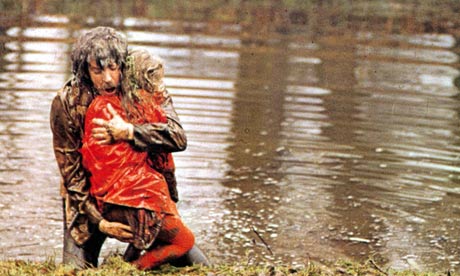Fig. 1. Don't Look Now poster.
Don’t Look Now flouts conventional editing in favour of a bizarre, stream-of-consciousness style featuring flashbacks, flash-forwards and intercutting of scenes to make the viewer wonder what exactly is going on. This is in keeping with one of the film’s major themes, that of precognition; past and future are intertwined to the point where they cannot be distinguished.
Telling the story of a grieving couple after the loss of their daughter to drowning, Don’t Look Now features the ultimately self-fulfilling prophecy of a psychic lady who warns the protagonist, John Baxter, that his life is in danger in Venice. John constantly notices a small figure clad in red out of the corner of his eye – significant in that his daughter wore a red jacket when she died. John mistrusts the psychic and her sister, whom he fears are manipulating his wife, but ultimately, as with the editing of the film, nothing is as it seems. The figure in red turns out to be a small, elderly serial killer, a fact John finds out too late. “Don’t Look Now is a deeply unsettling film as it forces the audience into the same position as the film’s protagonist: just like John Baxter, we know that something is coming; we know that it is not going to be good but we are powerless to avoid it.” (McCalmont, 2011)
Fig. 2. Baxter and Laura still.
Visually, Don’t Look Now is reminiscent of Schindler’s List in its mostly grey colour scheme, with occasional moments of bright red. As well as the obvious symbolism of blood, it acts to immediately point out things the viewer should notice, namely the daughter and he apparition that John repeatedly notices around Venice. Similarly the motif of water is used to represent death, and given that Venice is surrounded by water it is the perfect location for it. The Baxters’ daughter Christine drowns, John drops a glass of water on a photograph just as she dies, bodies are periodically hauled out of the Venetian canals in reference to the serial killer… the list goes on.
Fig. 3. Water on glass still.
The figure of the serial killer is, until the ending, only seen out of the corner of the camera’s ‘eye’, never giving the viewer enough time to assess it. As such, the viewer feels somewhat out-of-touch with reality, aware that something is going on but never knowing enough to work out what.
Another powerful piece of camerawork is the regular use of mirror shots. A simple shot is shown, but the camera zooms out until it is clear the viewer has been seeing the image backwards. This is perhaps an apt metaphor for the theme of the film; the presentation of one interpretation of events is shown to be completely wrong, and is deliberately used for jarring effect. The film’s editing in general is bizarre and dreamlike; “Unexpected cuts and fades slice through the story, connecting and separating themes and elements; a reflection blurs into a face, a mirror into a memory. Nothing is quite as it seems, as if the surface hides a whole other world, one governed by different rules.” (Cannon, 1999)
Illustration List
Fig. 1. Roeg, N. (1973). Don't Look Now poster. http://edgarwrighthere.com/wp-content/uploads/2009/10/DLNFullEW.jpg (Accessed on: 19/01/2012)
Fig. 2. Roeg, N. (1973). Baxter and Laura still. http://static.guim.co.uk/sys-images/Guardian/Pix/pictures/2011/1/18/1295375015857/DONT-LOOK-NOW-1973-DONALD-007.jpg (Accessed on: 19/01/2012)
Fig. 3. Roeg, N. (1973). Water on glass still. http://cinemasights.files.wordpress.com/2011/10/dontlooknow-opening.jpg (Accessed on: 19/01/2012)
Bibliography
McCalmont, J. (2011). Ruthlessculture.com. http://ruthlessculture.com/2011/11/08/review-dont-look-now-1973/
Cannon, D. (1999). Film-U.net. http://www.film.u-net.com/Movies/Reviews/Dont_Look_Now.html (Accessed on: 19/01/2012)




No comments:
Post a Comment